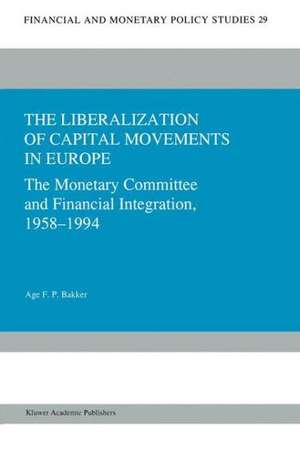The Liberalization of Capital Movements in Europe: The Monetary Committee and Financial Integration, 1958-1994: Mathematics and Its Applications, cartea 29
Autor Age Bakker, A. F. P. Bakkeren Limba Engleză Hardback – 30 noi 1995
Din seria Mathematics and Its Applications
- 9%
 Preț: 627.25 lei
Preț: 627.25 lei - 18%
 Preț: 945.62 lei
Preț: 945.62 lei - 15%
 Preț: 648.42 lei
Preț: 648.42 lei - 15%
 Preț: 651.99 lei
Preț: 651.99 lei - 15%
 Preț: 591.61 lei
Preț: 591.61 lei -
 Preț: 394.29 lei
Preț: 394.29 lei - 18%
 Preț: 950.17 lei
Preț: 950.17 lei - 15%
 Preț: 586.85 lei
Preț: 586.85 lei - 5%
 Preț: 655.17 lei
Preț: 655.17 lei - 15%
 Preț: 658.70 lei
Preț: 658.70 lei - 15%
 Preț: 648.56 lei
Preț: 648.56 lei - 15%
 Preț: 604.84 lei
Preț: 604.84 lei -
 Preț: 394.87 lei
Preț: 394.87 lei - 15%
 Preț: 651.84 lei
Preț: 651.84 lei -
 Preț: 374.76 lei
Preț: 374.76 lei -
 Preț: 394.51 lei
Preț: 394.51 lei - 15%
 Preț: 706.30 lei
Preț: 706.30 lei -
 Preț: 391.02 lei
Preț: 391.02 lei -
 Preț: 389.70 lei
Preț: 389.70 lei - 15%
 Preț: 585.04 lei
Preț: 585.04 lei - 15%
 Preț: 653.98 lei
Preț: 653.98 lei - 15%
 Preț: 587.02 lei
Preț: 587.02 lei - 20%
 Preț: 577.43 lei
Preț: 577.43 lei -
 Preț: 395.47 lei
Preț: 395.47 lei - 15%
 Preț: 601.88 lei
Preț: 601.88 lei - 15%
 Preț: 594.53 lei
Preț: 594.53 lei - 15%
 Preț: 651.84 lei
Preț: 651.84 lei - 15%
 Preț: 649.06 lei
Preț: 649.06 lei -
 Preț: 392.21 lei
Preț: 392.21 lei - 15%
 Preț: 649.06 lei
Preț: 649.06 lei - 15%
 Preț: 643.48 lei
Preț: 643.48 lei -
 Preț: 389.49 lei
Preț: 389.49 lei
Preț: 587.50 lei
Preț vechi: 691.17 lei
-15% Nou
Puncte Express: 881
Preț estimativ în valută:
112.43€ • 122.08$ • 94.44£
112.43€ • 122.08$ • 94.44£
Carte tipărită la comandă
Livrare economică 23 aprilie-07 mai
Preluare comenzi: 021 569.72.76
Specificații
ISBN-13: 9780792335917
ISBN-10: 0792335910
Pagini: 340
Dimensiuni: 160 x 240 mm
Greutate: 0.67 kg
Editura: Kluwer Academic Publishers
Seria Mathematics and Its Applications
Locul publicării:Dordrecht, Netherlands
ISBN-10: 0792335910
Pagini: 340
Dimensiuni: 160 x 240 mm
Greutate: 0.67 kg
Editura: Kluwer Academic Publishers
Seria Mathematics and Its Applications
Locul publicării:Dordrecht, Netherlands
Public țintă
ResearchCuprins
1. Introduction. 2. Capital restrictions: classification and general observations. 3. The Treaty of Rome and capital movements. 4. The role of the Monetary Committee. 5. The 1960s: lost momentum. 6. The 1970s: lost control. 7. The 1980s: liberalization and deregulation. 8. Towards the full liberalization of capital movements. 9. Towards Economic and Monetary Union. 10. Conclusion. Chronology of major measures with respect to the regime of capital movements in the member states of the European Community. Chronology of general events in Europe. Annexes. Literature. Index A: subjects. Index B: persons.
